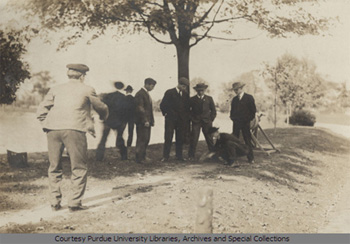Transportation Engineering at Purdue

When automobiles became more common in the 1920s, Purdue's School of Civil Engineering began attracting a large number of students in the academic specialty of transportation. Today, there is a significant focus on transportation research at Purdue University because of three programs focused on Indiana's people: the Purdue Road School, the Joint Highway Research Project, and the Highway Extension and Research Project for Indiana counties and cities. In January 1913, W. K. Hatt, head of the School of Civil Engineering, issued a call for a Civil Engineering Conference. The meeting covered the needs of county surveyors and city engineers and included essential discussions on roads and streets. During a similar conference held the next year, a resolution was passed calling for a provision in Indiana law instituting a yearly "School of Good Roads." In 1915, the name of the conference was changed to what we know today as the "Purdue Road School," which is celebrating its 100th anniversary this year.

By 1936, cars had been a fixture in American life for about 20 years, and the State Highway Commission of Indiana was charged with building roads to handle them. But problems followed. Portions of the pavement were exploding, for instance, leaving huge gaping holes in roads.
A. A. Potter, then dean of Purdue's Schools of Engineering, learned of the dilemma when talking to an administrator of the State Highway Commission. Potter suggested that Purdue could help. He enlisted the expertise of several Civil Engineering professors. The researchers discovered that the type of rock used in the concrete was too porous, allowing moisture to expand the pavement. That discovery paved the way, literally and figuratively, for the beginning of the Joint Highway Research Project, a partnership between Purdue and the State of Indiana.
The project was formalized on March 11, 1937, when the legislature voted to "cooperate with and assist Purdue University in developing the best methods of improving and maintaining the highways of the state and respective counties."

The Joint Highway Research Project celebrates its 75th anniversary this year. The project is a milestone for Purdue's land-grant mission to take the research and knowledge of the university to the people of Indiana. It broadened the research interests of the School of Civil Engineering, while providing great benefits to Indiana and its cities. Other states patterned their programs after Indiana's project. In 1959 a third road program, the Highway Extension and Research for Indiana Counties and Cities, was formalized by the Legislature. This last action brought together all parties of the state, including local authorities, to plan and implement highway research.
Over the years, Purdue researchers have evaluated the durability of concrete. They have analyzed pavement costs and maintenance management. Purdue engineers have completed highway speed and traffic problem studies and created detailed drainage and soil maps of Indiana counties. They have provided a county road naming and marking study. For the past five years, the Major Moves road improvement project has given future engineers the kind of experience in building roads that had not been available since the 1970s.

The projects implemented at Purdue in transportation since 1937 are both diverse and large in number - many made possible through a mutually beneficial liaison between the state and the University. The state receives help with pressing roadway problems, and Purdue receives money to support real-life research for graduate students. Internships and co-ops also provide on-the-job training for Purdue Civil Engineers.
Today's Transportation Engineering student in Purdue's School of Civil Engineering develops a strong foundation in design and operation of highways, airports, railroads and public transit. The ultimate goal for students, educators and the Purdue/Indiana affiliated programs is to ensure safe and efficient travels along the highways and byways of Indiana, America and beyond.

